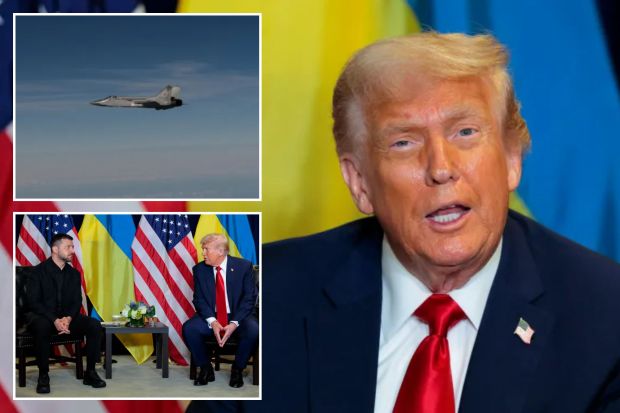World
Trump Urges NATO to Act Against Russian Aircraft Incursions

In a recent press conference, Donald Trump urged NATO member countries to take decisive action against Russian aircraft that violate allied airspace. He specifically stated that NATO should “shoot down” such jets, although he refrained from committing the United States to automatically support allied military actions if Russia retaliates.
Trump emphasized that NATO members “shouldn’t hesitate” to respond to incursions, but when pressed on whether the U.S. would back them militarily, he responded, “That depends on the circumstance.” This remark reflects a significant departure from NATO’s current approach, which has prioritized de-escalation. Earlier this month, NATO jets escorted Russian aircraft out of Estonian airspace without engaging, a strategy aimed at reducing the risk of conflict.
Tensions have escalated in recent weeks, highlighted by incidents involving Russian drones. On September 9 and 10, Polish authorities reported that a Russian drone had crossed into their airspace, which Warsaw deemed a “provocation to test NATO’s defenses.” Similar provocative actions have also occurred near Romania and in the Baltic region, raising alarms among NATO countries.
Trump’s comments align with his ongoing pressure campaign on European NATO allies, whom he has frequently criticized for not meeting defense spending targets. He has also called for an end to Russian oil imports, further intensifying the geopolitical discourse surrounding NATO’s readiness and response capabilities. Earlier this month, the Trump administration took a controversial step by cutting U.S. funding for security programs in Eastern Europe that were designed to counter Russian threats.
The President’s statements have sparked debate about the future of NATO’s collective defense strategy and its implications for global security dynamics. As tensions with Russia continue to mount, the alliance faces critical decisions on how to respond effectively while balancing the need for deterrence with the risks of escalation.
As this situation develops, NATO’s actions and member countries’ responses will be closely scrutinized, particularly in light of Trump’s ambiguous stance on U.S. military support for its allies. The coming weeks will likely reveal more about how NATO plans to navigate this increasingly complex geopolitical landscape.
-

 Entertainment3 months ago
Entertainment3 months agoAnn Ming Reflects on ITV’s ‘I Fought the Law’ Drama
-

 Entertainment4 months ago
Entertainment4 months agoKate Garraway Sells £2 Million Home Amid Financial Struggles
-

 Health3 months ago
Health3 months agoKatie Price Faces New Health Concerns After Cancer Symptoms Resurface
-

 Entertainment3 months ago
Entertainment3 months agoCoronation Street’s Carl Webster Faces Trouble with New Affairs
-

 Entertainment3 months ago
Entertainment3 months agoWhere is Tinder Swindler Simon Leviev? Latest Updates Revealed
-

 Entertainment4 months ago
Entertainment4 months agoMarkiplier Addresses AI Controversy During Livestream Response
-

 Science1 month ago
Science1 month agoBrian Cox Addresses Claims of Alien Probe in 3I/ATLAS Discovery
-

 Health4 months ago
Health4 months agoCarol Vorderman Reflects on Health Scare and Family Support
-

 World2 weeks ago
World2 weeks agoBailey Announces Heartbreaking Split from Rebecca After Reunion
-

 Entertainment4 months ago
Entertainment4 months agoKim Cattrall Posts Cryptic Message After HBO’s Sequel Cancellation
-

 Entertainment3 months ago
Entertainment3 months agoOlivia Attwood Opens Up About Fallout with Former Best Friend
-

 Entertainment2 weeks ago
Entertainment2 weeks agoCoronation Street Fans React as Todd Faces Heartbreaking Choice





















